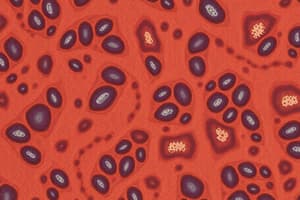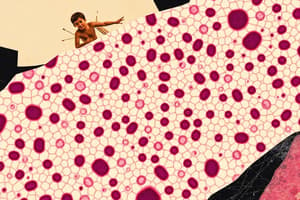Podcast
Questions and Answers
What is the arrangement pattern of microtubules within motile cilia?
What is the arrangement pattern of microtubules within motile cilia?
- 10+2 arrangement
- 9+2 arrangement (correct)
- 8+2 arrangement
- 9+0 arrangement
Which of the following structures joins with basal bodies in a 9+0 arrangement?
Which of the following structures joins with basal bodies in a 9+0 arrangement?
- Axoneme
- Non-motile cilia
- Flagella
- Motile cilia (correct)
What components make up the junctional complex in epithelial cells?
What components make up the junctional complex in epithelial cells?
- Tight junctions, Gap junctions, Hemidesmosomes
- Zonula occludens, Gap junctions, Tight junctions
- Zonula occludens, Zonula adherens, Desmosomes (correct)
- Desmosomes, Adhering junctions, Basal membranes
Which type of junction primarily functions as a barrier in epithelial cells?
Which type of junction primarily functions as a barrier in epithelial cells?
Which specializations are distinct on different surfaces of epithelial cells?
Which specializations are distinct on different surfaces of epithelial cells?
What is a characteristic feature of epithelium?
What is a characteristic feature of epithelium?
Which of the following types of epithelial tissue has only one layer of cells?
Which of the following types of epithelial tissue has only one layer of cells?
What type of epithelium is primarily involved in the exchange of materials, absorption, and secretion?
What type of epithelium is primarily involved in the exchange of materials, absorption, and secretion?
Which property is NOT characteristic of epithelial tissues?
Which property is NOT characteristic of epithelial tissues?
Which type of epithelium is responsible for lining the heart, blood vessels, and lymphatics?
Which type of epithelium is responsible for lining the heart, blood vessels, and lymphatics?
Which layer of epithelial tissue would be found lining the peritoneal and pleural cavities?
Which layer of epithelial tissue would be found lining the peritoneal and pleural cavities?
In epithelial tissue, what does the term 'morphological polarity' refer to?
In epithelial tissue, what does the term 'morphological polarity' refer to?
What type of epithelial tissue is characterized by multiple layers of cells that can change shape?
What type of epithelial tissue is characterized by multiple layers of cells that can change shape?
What is the primary function of tight junctions in epithelial cells?
What is the primary function of tight junctions in epithelial cells?
Which junction is primarily responsible for cell-cell communication?
Which junction is primarily responsible for cell-cell communication?
Adhering junctions mainly function to:
Adhering junctions mainly function to:
Which component is associated with desmosomes?
Which component is associated with desmosomes?
What role do cadherins play in adhering junctions?
What role do cadherins play in adhering junctions?
Which epithelial structure exemplifies specialization for active absorption and secretion?
Which epithelial structure exemplifies specialization for active absorption and secretion?
Which of the following is NOT a type of junction found in the junctional complex?
Which of the following is NOT a type of junction found in the junctional complex?
What type of junction is characterized by a seal that restricts substance movement?
What type of junction is characterized by a seal that restricts substance movement?
What is a major function of simple cuboidal epithelium?
What is a major function of simple cuboidal epithelium?
Which type of epithelium is primarily associated with the respiratory tract?
Which type of epithelium is primarily associated with the respiratory tract?
What distinguishes keratinized stratified squamous epithelium from non-keratinized type?
What distinguishes keratinized stratified squamous epithelium from non-keratinized type?
In which location would you expect to find simple columnar epithelium?
In which location would you expect to find simple columnar epithelium?
Which type of epithelial tissue is primarily used for protection?
Which type of epithelial tissue is primarily used for protection?
What is a distinguishing feature of non-keratinized stratified squamous epithelium?
What is a distinguishing feature of non-keratinized stratified squamous epithelium?
Where would you most likely find stratified squamous keratinized epithelium?
Where would you most likely find stratified squamous keratinized epithelium?
Which epithelial type is characterized by cells that are taller than they are wide?
Which epithelial type is characterized by cells that are taller than they are wide?
What type of staining is characteristic of salivary gland cells?
What type of staining is characteristic of salivary gland cells?
Which type of secretion involves the cell rupturing to release its products?
Which type of secretion involves the cell rupturing to release its products?
Which gland is an example of a merocrine secretion mechanism?
Which gland is an example of a merocrine secretion mechanism?
What is the nature of secretory products in mucin-producing glands?
What is the nature of secretory products in mucin-producing glands?
Which structure classification refers to glands with branched ducts?
Which structure classification refers to glands with branched ducts?
Which type of cell arrangement is found in the serous demilune of the salivary gland?
Which type of cell arrangement is found in the serous demilune of the salivary gland?
Which of the following represents a feature of apocrine secretion?
Which of the following represents a feature of apocrine secretion?
What term describes glands that contain a mix of mucin and protein secretory products?
What term describes glands that contain a mix of mucin and protein secretory products?
Study Notes
Characteristics of Epithelium
- Resides on a basement membrane providing structural support.
- Features a junctional complex with tight junctions, adhering junctions, and desmosomes that facilitate cell communication and strength.
- Avascular, relying on nearby connective tissues for nutrient exchange.
- Exhibits distinct functional and morphological polarity, with specialized structures on different surfaces.
- Composed of cytokeratin, a type of intermediate filament protein.
- Contains minimal intercellular matrix, in contrast to connective tissues.
Classification of Epithelia
- Classified by cell shape and number of layers:
- Simple (one layer)
- Stratified (multiple layers)
- Cell shapes include:
- Squamous: flat, facilitating diffusion and filtration.
- Cuboidal: cube-shaped, involved in secretion and absorption.
- Columnar: tall, helping with secretion and absorption; often includes cilia.
Types of Simple Epithelium
- Simple Squamous Epithelium:
- Facilitates material exchange, found in lining of heart, blood vessels, and peritoneal/pleural cavities.
- Simple Cuboidal Epithelium:
- Functions in secretion, excretion, and absorption; located in ducts of glands and kidney tubules.
- Simple Columnar Epithelium:
- Involved in fluid transportation, secretion, and absorption; found in intestinal and gall bladder linings.
- Simple Ciliated Columnar Epithelium:
- Contains cilia for movement, seen in structures like the fallopian tube.
Types of Stratified Epithelium
- Stratified Squamous Epithelium (non-keratinized):
- Provides protection, features living nuclei, located in areas like the uterine cervix.
- Stratified Squamous Epithelium (keratinized):
- Offers surface protection against desiccation, with dead cells rich in keratin, found in skin areas like the soles of feet.
Morphological Polarity of Epithelial Cells
- Exhibits distinct structures on opposite surfaces; basal surface adaptations are critical for functions like absorption and secretion.
Specializations at the Lateral Surface
- Junctional Complex consists of:
- Tight Junctions (ZO): Provide seals between cells, restricting passage of substances.
- Adhering Junctions (ZA): Connect cells via protein layers and microfilaments, reinforcing cell integrity.
- Desmosomes: Strengthen interactions between cells through intermediary filament networks.
Gap Junctions
- Facilitate intercellular communication, allowing ions and small molecules to transfer between adjacent cells.
Specializations at the Basal Surface
- Important for active processes such as absorption in structures like kidney tubules and salivary gland ducts.
Modes of Secretion in Glandular Epithelium
- Merocrine Secretion: Involves exocytosis without loss of cytoplasm (e.g., sweat glands).
- Apocrine Secretion: Involves partial loss of cytoplasm, seen in mammary glands.
- Holocrine Secretion: Entire cell ruptures to release secretory products (e.g., sebaceous glands).
Classification of Exocrine Glands
- Single cell: Goblet cells.
- Multicellular: Can be simple or compound based on duct branching.
- Secretory structures: Tubular, acinar, or mixed.
- Secretory products: Mucin, protein, or both.
This classification is key for understanding the diverse roles that epithelial tissues play in different organs and systems within the body.
Studying That Suits You
Use AI to generate personalized quizzes and flashcards to suit your learning preferences.
Related Documents
Description
This quiz explores the fundamental characteristics and classification of epithelial tissues. Understand the structure, types, and functions of simple and stratified epithelia, as well as their unique features. Test your knowledge on both the morphology and functionality of epithelial cells.




